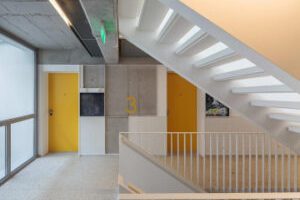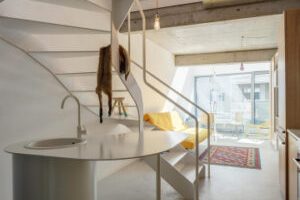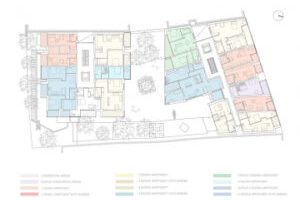




Urban Spaces 1 / Dogarilor Apartment Building
Main objectives of the project
Located in Mulhouse's popular district near the city center, this project consists of 59 social rental dwellings developed by SOMCO. Our goal is to provide generous dwellings without increasing rent. We aim to address the issue of densification in Bucharest's central area while preserving the qualities of the existing neighborhood. The building design seeks to maintain the narrow plots' porosity and blend with the surrounding collage-like appearance. It balances the required alignment with the specific characteristics of the street and urban fabric. The apartments offer diverse typologies, ranging from studios to four-bedroom units, with private courtyards, balconies, or terraces. Common spaces, commercial areas, and ateliers are also included. The flexible design allows for unit combinations, resulting in a total of 77 residential units and approximately 50 apartment types. Site size: 2082 m2; Building size: 8931 m2.
Date
- 2014: Construction
Stakeholders
- Architect: ADN Birou de Arhitectura
Location
City: Bucharest
Country/Region: Bucharest, Romania
Description
The project is located in Mulhouse in a popular district close to the city center, currently under renovation. It includes 59 social rental dwellings developed by SOMCO, operator on public social housing. A few years after the Cité Manifeste experience, our common goal was to pursue the same aims: generous dwellings without increasing the rent. One of the most important and problematic aspects of nowadays Bucharest is the fast densification of the central area. While we believe that density can, and many times must be seen as a form of sustainability, we also admit that the often fragile relationship between habitation within an old neighborhood and the increase of density could many times alter the place and reduce its existing qualities.
Our project is looking for an appropriate answer to this problem. It tries to mediate between different sizes and densities, in a quite central neighborhood characterized by small streets, long, narrow plots and a puzzle of old and new buildings of all types and scales. The building searches to preserve, at its own scale, the porosity and “profoundness” of the deep, narrow plots, while also trying to capture part of the “collage”-like appearance of the surroundings. The volumetric proposal seeks to partially open the building to the street, in the depth of the plot. Because of this, the volume facing the street is less compact and the ground floor is more transparent, in order to allow a better visual connection at eye s level. In this way, we have also tried to mediate between the continuous alignment required by the urban regulation and the specific of the street and of the surrounding urban fabric, characterized by fragmentation. At the same time, the project proposes a type of habitation which we consider suitable for the center of the contemporary city: a place where the relatively small spaces and the density are complemented by diversity and wider common spaces. Most of the apartments are different from one another, not only in size, but especially in typology: they range from studios to four-bedroom apartments – each one of them laying on one, two or even three floors and having private courtyards, balconies or terraces of different sizes. They all are complemented by several indoor and outdoor common spaces (terraces, party room, large halls etc.), while the ground floor offers several commercial spaces and ateliers to rent, towards the street and the inner courtyard. The apartments are conceived in such way as to allow a great deal of flexibility, making it possible to connect (horizontally or vertically) two or more small units into a larger one, leading, in the end, at a building consisting of 77 residential units offering approx. 50 types of apartments. Size of the site: 2082 m2; Size of the building: 8931 m2
